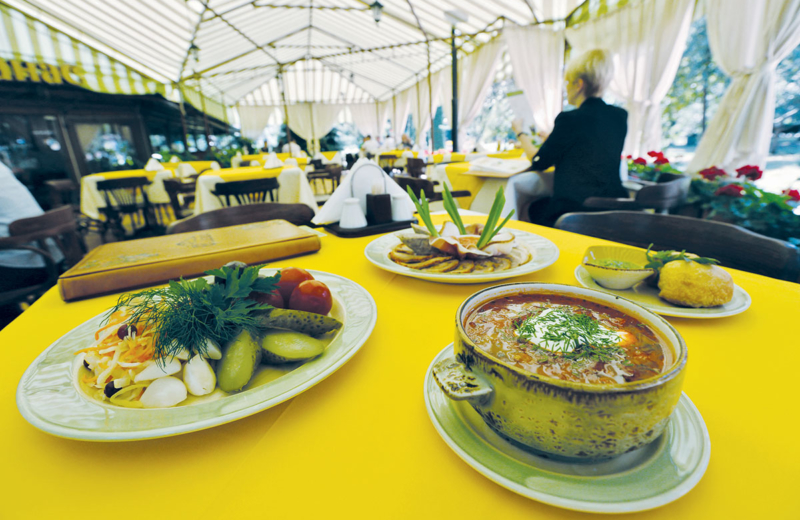Readers may think they know all there is to know about borscht, Ukraine’s traditional beetroot soup — one of the most popular dishes in the country. But there are some myths and mysteries surrounding this hearty mealtime favorite that will surprise many.
Ukrainians have been eating borscht since the times of the Kyivan Rus, haven’t they?
No they haven’t — even though many people in Ukraine think so.
Borscht was first mentioned in literature and academic work starting from the late 18th century. In 1798, Ivan Kotlyarevsky writes about it in his “Eneyida,” a parody of the Roman poet Virgil’s “Aeneid,” while ethnographer Mykola Markevych mentions it in a book written some 60 years later. By that time, borscht was certainly already a firm favorite in Ukraine.
Despite being popular in Ukraine, borscht is actually Russian, right?
Wrong. Even a Russian culinary book published in 1892 says borscht is a “Malorosiysky” dish, meaning the one from “Little Russia,” as Russians used to call Ukraine in the time of the Russian empire. It was also described as a Podolsky dish, referring to the region of west-central and south-western parts of Ukraine, historically known as Podilia.
The main reason why some still think borscht is a Russian dish is that during Soviet times, the authorities tried to erase cultural differences between constituent republics — everything was described as Russian.
And during the 20th century, many emigrants moved from Ukraine and Russia to various countries. Both Ukrainians and Russians made borscht in their new homes, and it was sometimes mistaken as a purely Russian dish.
Can borscht be cooked with fish?
Yes, it can.
The most familiar recipes for borscht include the basic ingredients of beetroots, cabbage, potatoes, tomatoes, and meat — either pork or beef.
But there are at least 12 acknowledged recipes of genuine borscht found in cookery books. On top of that, the various Ukrainian regions have different traditions for cooking borscht. For example, in western Ukraine, people usually cook borscht without cabbage. Some add dumplings without any filling to the dish.
Some versions are influenced by Ukraine’s religious traditions, which mean that almost for half a year people don’t eat meat. So people may cook borscht without meat, or replace meat with kidney beans, mushrooms, or fish (usually crucian carp). These options might suit vegetarians or vegans as well.

Borscht is easy to cook, and it always tastes the same, doesn’t it?
Not at all. Anyone who has eaten borscht knows there’s no one way to cook it, and how it tastes depends on the person who makes it. It doesn’t mean that they’re not following the recipe — it’s just that there’s no canonic recipe for borscht — just the traditional ingredients, which can be built on in a huge variety of ways. For Ukrainians, their favorite borscht is usually the one cooked by their parents or grandparents.
For Ukrainians, borscht is comfort food — it helps them overcome homesickness or the absence of loved ones.
For expatriates or tourists, it’s an interesting experience to taste borscht made by different people, and to try to identify the traits that make each bowlful unique, but still an example of a traditional borscht.
Borscht is healthy and can be part of a calorie-controlled diet.
Yes it can. On average, depending on the recipe, borscht provides 40 to 70 kcal per 100 grams. That means a person could have from 10 to 14 bowls of borscht a day to obtain the average daily intake of calories.
As borscht contains a variety of vegetables and meat, it provides a good balance of carbohydrates, protein, and fats. Moreover, borscht is easy to transform into a vegetarian or a low-calorie dish.
Where to eat borscht in Kyiv:
O’Panas. 10 Tereshchinkivska St. Mon-Sun. 9:30–12 a. m. +38044 585 0523
Borscht — Hr 86
This restaurant offers traditional borscht cooked with pork ribs.
Kanapa. 19 Andriyivsky Descent. Mon-Sun. 10 a. m.— until the last guest. +38044 425 4548
Borscht — Hr 149
This place cooks its borscht according to a Chernihiv recipe, adding pork ears and prunes. They all serve borscht in a bowl made from a head of cabbage.
Spotykach. 16 Volodymyrska St. Mon-Sun. 11–12 a. m. +38 044 586 4095
Borscht, iced borscht, space borscht — Hr 95
Apart from the traditional types, Spotykach also offers iced borscht in the form of ice cream, and space borscht, served in a tube as used by astronauts.
Barvy. 16 Mechnykova St. MonThu. 10 a. m. — 11 p. m., Fri-Sat 10–3 a. m. +38098 306 3333
Borscht — Hr 125
This restaurant offers borscht prepared with game meat (wild boar, roe deer). And during religious fasting periods such as Lent they offer borscht with mushrooms instead of meat.
Editor’s note: For information about borscht, the Kyiv Post consulted Julia Aurora Ogorodnyk, a food writer and a co-author of the book “Made in Ukraine,” and Olena Braichenko, a historian and a researcher of Ukrainian gastronomic culture.



